The global 1-methoxynaphthalene-2-boronic acid market is projected to expand from USD 15.1 million in 2025 to USD 34.5 million by 2035, representing an absolute gain of USD 19.4 million. This reflects the overall growth of 128.3% with the 1-methoxynaphthalene-2-boronic acid market forecast to rise at a CAGR of 8.6% during the assessment period. The industry is expected to grow by approximately 2.28 times in value, supported by the increasing adoption of boronic acid derivatives across pharmaceutical synthesis, research programs, and specialty chemical manufacturing. The compound is gaining wider recognition as a critical building block in advanced organic synthesis, with applications stretching from drug discovery to high-value material science research.
From 2025 to 2030, the 1-methoxynaphthalene-2-boronic acid market is projected to rise from USD 15.1 million to USD 22.9 million, representing a USD 7.8 million increase, which accounts for 40.2% of the decade’s expansion. This period will be characterized by accelerated demand from pharmaceutical manufacturers as they integrate boronic acid intermediates into their drug development pipelines. Increasing requirements for selectivity in cross-coupling reactions and precision in molecular frameworks are expected to reinforce adoption. High-purity grades are being prioritized as pharmaceutical and biotechnology companies intensify their investments in discovery and clinical-stage research, ensuring minimal impurities and superior reproducibility across laboratory processes.
The second half of the decade, spanning 2030 to 2035, is forecast to deliver faster momentum with market value advancing from USD 22.9 million to USD 34.5 million. This addition of USD 11.6 million constitutes nearly 60% of the forecasted growth. This phase will be marked by the wider application of the compound across contract research organizations (CROs) and contract development and manufacturing organizations (CDMOs), which are expanding their portfolios to include specialized intermediates. Expansion of global pharmaceutical outsourcing models, combined with the growing role of niche organic molecules in targeted therapies, will provide a favorable backdrop for industry participants.
Beyond pharmaceuticals, adoption in specialty organic synthesis and materials science is creating new opportunities. Research institutes are increasingly leveraging 1-methoxynaphthalene-2-boronic acid for structural modifications in advanced polymers, coatings, and nanomaterials. The compound’s unique reactivity profile and ability to deliver enhanced molecular stability make it an attractive option in exploratory research settings. With universities and industrial R&D labs focusing on next-generation chemistry applications, demand is expected to gain broader traction beyond its traditional stronghold in pharmaceuticals.
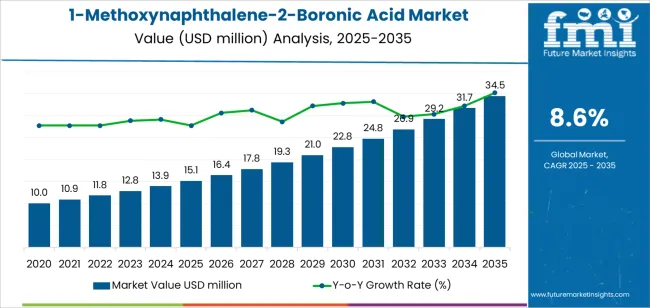
1-Methoxynaphthalene-2-Boronic Acid Market Key Takeaways
| Metric | Value |
|---|---|
| Estimated Value in (2025E) | USD 15.1 million |
| Forecast Value in (2035F) | USD 34.5 million |
| Forecast CAGR (2025 to 2035) | 8.6% |
From 2030 to 2035, the 1-methoxynaphthalene-2-boronic acid market is forecast to grow from USD 22.9 million to USD 34.5 million, adding another USD 11.6 million, which constitutes 59.8% of the overall ten-year expansion. This period is expected to be characterized by the expansion of pharmaceutical manufacturing applications, the integration of advanced purification technologies, and the development of specialized synthesis protocols with enhanced reaction efficiency capabilities. The growing adoption of precision chemistry practices will drive demand for 1-methoxynaphthalene-2-boronic acid with superior purity standards and compatibility with advanced pharmaceutical manufacturing processes across drug development operations.
Between 2020 and 2025, the 1-methoxynaphthalene-2-boronic acid market experienced robust growth, driven by increasing demand for specialized pharmaceutical intermediates and growing recognition of boronic acid derivatives as essential building blocks for advanced organic synthesis across pharmaceutical research, materials science, and chemical manufacturing applications. The 1-methoxynaphthalene-2-boronic acid market developed as pharmaceutical companies recognized the potential for specialized boronic acids to enable complex molecular transformations while maintaining reaction selectivity and enabling cost-effective synthesis protocols. Technological advancement in
Market expansion is being supported by the increasing global demand for specialized pharmaceutical intermediates and the corresponding need for advanced chemical building blocks that can provide superior reaction selectivity and synthesis efficiency while enabling reduced byproduct formation and enhanced yield optimization across various pharmaceutical and materials synthesis applications.
Modern pharmaceutical operations and specialty chemical manufacturers are increasingly focused on implementing boronic acid derivatives that can deliver targeted molecular transformations, prevent unwanted side reactions, and provide consistent performance throughout complex synthesis sequences and diverse reaction conditions. 1-Methoxynaphthalene-2-boronic acid's proven ability to deliver exceptional selectivity in cross-coupling reactions, enable efficient synthetic protocols, and support cost-effective manufacturing processes make them essential components for contemporary pharmaceutical and specialty chemical operations.
The growing emphasis on pharmaceutical innovation and advanced materials development is driving demand for 1-methoxynaphthalene-2-boronic acid that can support complex synthesis requirements, improve reaction outcomes, and enable automated manufacturing systems.
Pharmaceutical manufacturers' preference for chemical intermediates that combine high selectivity with operational reliability and synthesis efficiency is creating opportunities for innovative applications. The rising influence of precision chemistry and advanced manufacturing practices is also contributing to increased demand for 1-methoxynaphthalene-2-boronic acid that can provide optimized reaction performance, reliable quality standards, and consistent results across extended production campaigns.
The 1-methoxynaphthalene-2-boronic acid market is poised for rapid growth and transformation. As industries across pharmaceuticals, specialty chemicals, materials science, and advanced manufacturing seek solutions that deliver exceptional synthesis selectivity, reaction efficiency, and manufacturing reliability, 1-methoxynaphthalene-2-boronic acid is gaining prominence not just as a specialized intermediate but as a strategic enabler of modern pharmaceutical development and advanced chemical synthesis.
Rising pharmaceutical innovation in Asia-Pacific and expanding specialty chemical manufacturing globally amplify demand, while manufacturers are leveraging innovations in purification technologies, synthesis optimization systems, and integrated quality control processes.
Pathways like ultra-high-purity formulations, pharmaceutical-grade synthesis protocols, and specialized application solutions promise strong margin uplift, especially in pharmaceutical and advanced materials segments. Geographic expansion and technology integration will capture volume, particularly where local pharmaceutical manufacturing and specialty chemical production are critical. Regulatory support around pharmaceutical quality standards, chemical purity requirements, and manufacturing excellence standards give structural support.
The 1-methoxynaphthalene-2-boronic acid market is segmented by purity grade, application, end-use sector, distribution channel, and region. By purity grade, the market is divided into 98% purity, 99% purity, and other categories. By application, it covers organic synthesis, display materials, pharmaceutical intermediates, and others. By end-use sector, it is categorized into pharmaceutical companies, research institutions, specialty chemical manufacturers, and academic laboratories. By distribution channel, the market includes direct sales, distributors, and online platforms. Regionally, the market is divided into North America, Europe, East Asia, South Asia & Pacific, Latin America, and the Middle East & Africa.
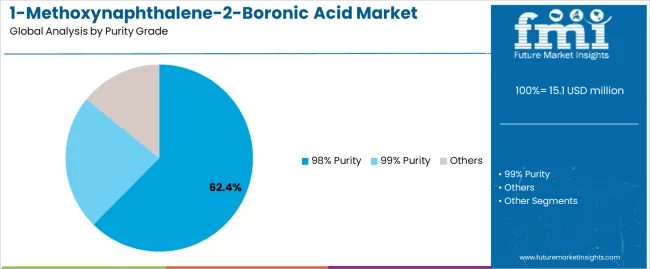
The 98% purity segment is projected to account for 62.4% of the 1-methoxynaphthalene-2-boronic acid market in 2025, reaffirming its position as the leading purity category. Pharmaceutical manufacturers and specialty chemical producers increasingly utilize 98% purity 1-methoxynaphthalene-2-boronic acid for their superior cost-effectiveness characteristics when operating in standard synthesis applications, excellent reaction compatibility properties, and reliability in applications ranging from pharmaceutical intermediates to specialty chemical synthesis management. Standard purity 1-methoxynaphthalene-2-boronic acid technology's proven synthesis performance capabilities and established quality standards directly address the industrial requirements for consistent performance in routine pharmaceutical manufacturing environments.
This purity segment forms the foundation of modern pharmaceutical synthesis operations, as it represents the chemical grade with the greatest market acceptance and established demand across multiple application categories and research sectors. Manufacturer investments in optimized synthesis processes and quality control systems continue to strengthen adoption among pharmaceutical contractors and specialty chemical enterprises. With companies prioritizing cost efficiency and performance reliability, 98% purity 1-methoxynaphthalene-2-boronic acid aligns with both performance requirements and economic efficiency objectives, making them the central component of comprehensive pharmaceutical synthesis strategies.
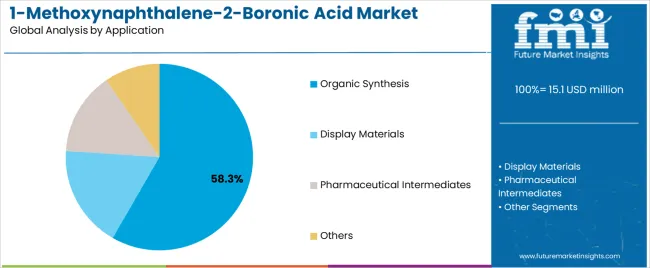
Organic synthesis applications are projected to represent 58.3% of 1-methoxynaphthalene-2-boronic acid demand in 2025, underscoring their critical role as the primary consumers of specialized boronic acid derivatives for pharmaceutical intermediate production, advanced chemical synthesis, and materials development applications. Organic synthesis specialists prefer 1-methoxynaphthalene-2-boronic acid for their exceptional selectivity capabilities, reliable reaction characteristics, and ability to enable complex molecular transformations while ensuring high yield outcomes throughout diverse synthesis protocols. Positioned as essential building blocks for modern pharmaceutical chemistry, 1-methoxynaphthalene-2-boronic acid offers both performance advantages and synthesis efficiency benefits.
The segment is supported by continuous innovation in cross-coupling technologies and the growing availability of specialized reaction systems that enable optimized synthesis conditions with enhanced selectivity and rapid reaction completion capabilities. Additionally, pharmaceutical manufacturers are investing in advanced synthesis platforms to support large-scale boronic acid utilization and process optimization. As pharmaceutical innovation demand becomes more prevalent and synthesis efficiency requirements increase, organic synthesis applications will continue to dominate the end-use market while supporting advanced pharmaceutical development utilization and specialty chemical synthesis strategies.
The 1-methoxynaphthalene-2-boronic acid market is advancing rapidly due to increasing demand for specialized pharmaceutical intermediates and growing adoption of advanced organic synthesis solutions that provide superior reaction selectivity and synthesis efficiency while enabling reduced byproduct formation across diverse pharmaceutical and specialty chemical manufacturing applications. However, the 1-methoxynaphthalene-2-boronic acid market faces challenges, including high raw material costs, stringent quality control requirements, and the need for specialized storage and handling protocols. Innovation in purification technologies and automated synthesis systems continues to influence product development and market expansion patterns.
Expansion of Pharmaceutical Manufacturing Applications
The growing adoption of advanced pharmaceutical synthesis, specialized drug development programs, and complex molecular assembly is enabling manufacturers to produce enhanced 1-methoxynaphthalene-2-boronic acid with superior purity specifications, improved reaction compatibility, and validated pharmaceutical manufacturing functionalities. Advanced pharmaceutical applications provide improved synthesis outcomes while allowing more efficient drug development and consistent performance across various therapeutic areas and synthesis conditions. Manufacturers are increasingly recognizing the competitive advantages of pharmaceutical-grade boronic acids for operational differentiation and premium market positioning.
Integration of Advanced Purification and Quality Control
Modern 1-methoxynaphthalene-2-boronic acid producers are incorporating advanced analytical methods, automated quality control systems, and integrated purity monitoring to enhance product specifications, enable predictive quality management, and deliver value-added solutions to pharmaceutical customers. These technologies improve manufacturing reliability while enabling new quality capabilities, including real-time purity monitoring, batch consistency tracking, and reduced quality overhead. Advanced quality integration also allows manufacturers to support comprehensive pharmaceutical manufacturing systems and chemical supply modernization beyond traditional manual quality approaches.
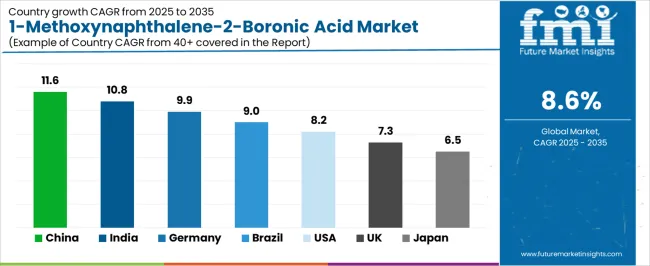
| Country | CAGR (2025 to 2035) |
|---|---|
| China | 11.6% |
| India | 10.8% |
| Germany | 9.9% |
| Brazil | 9% |
| USA | 8.2% |
| UK | 7.3% |
| Japan | 6.5% |
The 1-methoxynaphthalene-2-boronic acid market is experiencing strong growth globally, with China leading at an 11.6% CAGR through 2035, driven by the expanding pharmaceutical manufacturing sector, growing specialty chemical production, and significant investment in advanced chemical synthesis development. India follows at 10.8%, supported by government initiatives promoting pharmaceutical manufacturing, increasing API production demand, and growing pharmaceutical export requirements.
Germany shows growth at 9.9%, emphasizing pharmaceutical innovation and advanced chemical manufacturing development. Brazil records 9%, focusing on pharmaceutical industry expansion and specialty chemical modernization. The USA demonstrates 8.2% growth, prioritizing pharmaceutical excellence standards and specialty chemical manufacturing advancement. The UK exhibits 7.3% growth, emphasizing pharmaceutical technology adoption and chemical manufacturing development. Japan shows 6.5% growth, supported by high-tech pharmaceutical initiatives and precision chemical manufacturing concentration.
The report covers an in-depth analysis of 40+ countries, the top-performing countries are highlighted below.
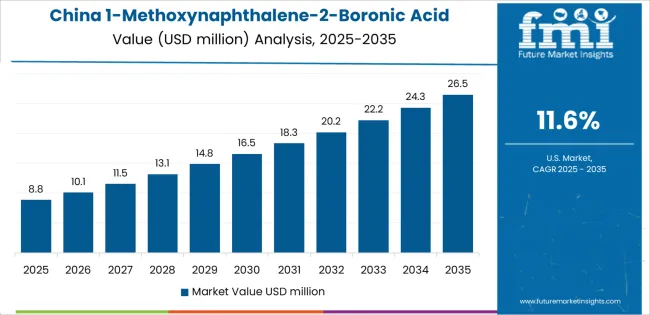
Revenue from 1-methoxynaphthalene-2-boronic acid in China is projected to exhibit exceptional growth with a CAGR of 11.6% through 2035, driven by expanding pharmaceutical manufacturing programs and rapidly growing specialty chemical production supported by government initiatives promoting chemical industry development. The country's strong position in pharmaceutical intermediate manufacturing and increasing investment in advanced chemical synthesis infrastructure are creating substantial demand for specialized boronic acid solutions.
Major pharmaceutical companies and chemical enterprises are establishing comprehensive synthesis operation capabilities to serve both domestic pharmaceutical demand and international specialty chemical markets.
Revenue from 1-methoxynaphthalene-2-boronic acid in India is expanding at a CAGR of 10.8%, supported by the country's massive pharmaceutical sector, expanding government support for pharmaceutical manufacturing, and increasing adoption of advanced chemical synthesis solutions. The country's initiatives promoting pharmaceutical export and growing pharmaceutical manufacturing capabilities are driving requirements for specialized pharmaceutical intermediates. International suppliers and domestic manufacturers are establishing extensive production and service capabilities to address the growing demand for high-purity boronic acid products.
Revenue from 1-methoxynaphthalene-2-boronic acid in Germany is expanding at a CAGR of 9.9%, supported by the country's advanced pharmaceutical capabilities, strong emphasis on chemical manufacturing innovation, and robust demand for high-performance pharmaceutical intermediates in drug development and specialty chemical applications. The nation's mature pharmaceutical sector and innovation-focused operations are driving sophisticated boronic acid systems throughout the pharmaceutical industry. Leading manufacturers and technology providers are investing extensively in advanced purification systems and specialized synthesis technologies to serve both domestic and international markets.
Revenue from 1-methoxynaphthalene-2-boronic acid in Brazil is growing at a CAGR of 9%, driven by the country's expanding pharmaceutical sector, growing chemical manufacturing operations, and increasing investment in pharmaceutical technology development. Brazil's pharmaceutical manufacturing expansion and commitment to chemical industry modernization are supporting demand for efficient boronic acid solutions across multiple pharmaceutical production segments. Manufacturers are establishing comprehensive service capabilities to serve the growing domestic market and pharmaceutical export opportunities.
Revenue from 1-methoxynaphthalene-2-boronic acid in the USA is expanding at a CAGR of 8.2%, supported by the country's advanced pharmaceutical technology sector, strategic focus on pharmaceutical innovation, and established specialty chemical manufacturing capabilities. The USA's pharmaceutical innovation leadership and technology integration are driving demand for specialized boronic acids in drug development, pharmaceutical manufacturing, and specialty chemical applications. Manufacturers are investing in comprehensive technology development to serve both domestic pharmaceutical markets and international specialty applications.
Revenue from 1-methoxynaphthalene-2-boronic acid in the UK is growing at a CAGR of 7.3%, driven by the country's focus on pharmaceutical technology advancement, emphasis on chemical manufacturing efficiency, and strong position in pharmaceutical innovation development. The UK's established pharmaceutical innovation capabilities and commitment to chemical manufacturing modernization are supporting investment in advanced boronic acid technologies throughout major pharmaceutical regions. Industry leaders are establishing comprehensive technology integration systems to serve domestic pharmaceutical operations and specialty chemical applications.
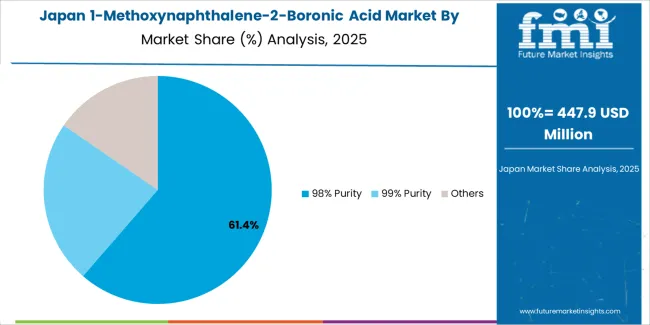
Revenue from 1-methoxynaphthalene-2-boronic acid in Japan is expanding at a CAGR of 6.5%, supported by the country's high-tech pharmaceutical initiatives, growing precision chemical sector, and strategic emphasis on pharmaceutical automation development. Japan's advanced technology capabilities and integrated pharmaceutical systems are driving demand for specialized 1-methoxynaphthalene-2-boronic acid in pharmaceutical manufacturing, precision synthesis, and high-value chemical applications. Leading manufacturers are investing in specialized capabilities to serve the stringent requirements of high-tech pharmaceutical and precision chemical industries.
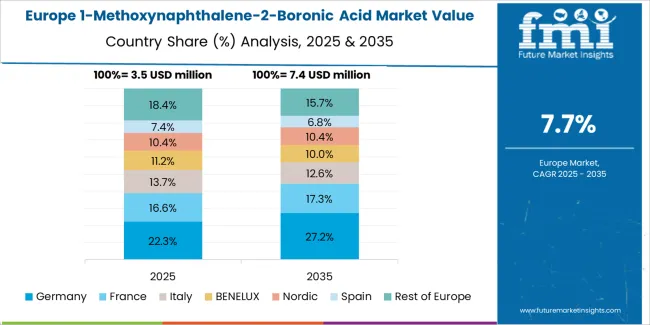
The 1-methoxynaphthalene-2-boronic acid market in Europe is projected to grow from USD 3.1 million in 2025 to USD 6.9 million by 2035, registering a CAGR of 8.3% over the forecast period. Germany is expected to maintain its leadership position with a 38.2% market share in 2025, declining slightly to 37.8% by 2035, supported by its strong pharmaceutical sector, advanced chemical manufacturing capabilities, and comprehensive pharmaceutical innovation industry serving diverse boronic acid applications across Europe.
France follows with a 16.8% share in 2025, projected to reach 17.2% by 2035, driven by robust demand for pharmaceutical intermediates in drug development, chemical manufacturing modernization programs, and specialty chemical applications, combined with established pharmaceutical technology infrastructure and chemical synthesis expertise.
The United Kingdom holds a 15.9% share in 2025, expected to reach 16.3% by 2035, supported by strong pharmaceutical technology sector and growing chemical manufacturing activities. Italy commands a 11.7% share in 2025, projected to reach 12.1% by 2035, while Spain accounts for 8.4% in 2025, expected to reach 8.7% by 2035. The Netherlands maintains a 4.6% share in 2025, growing to 4.8% by 2035.
The Rest of Europe region, including Nordic countries, Eastern Europe, Belgium, Poland, and other nations, is anticipated to maintain momentum, with its collective share moving from 4.4% to 3.1% by 2035, attributed to increasing pharmaceutical manufacturing in Eastern Europe and growing specialty chemical penetration in Nordic countries implementing advanced pharmaceutical technology programs.
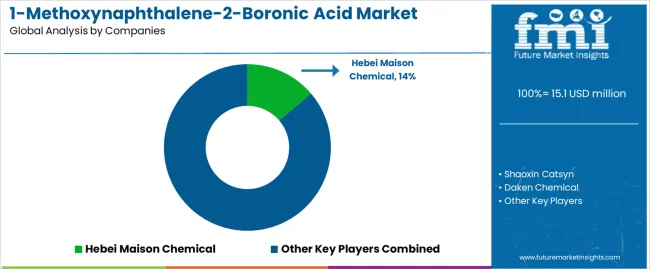
The 1-methoxynaphthalene-2-boronic acid market is characterized by competition among established specialty chemical manufacturers, pharmaceutical intermediate producers, and integrated fine chemical solutions providers. Companies are investing in purification technology research, synthesis process optimization, quality control system development, and comprehensive product portfolios to deliver consistent, high-performance, and application-specific 1-methoxynaphthalene-2-boronic acid solutions. Innovation in purity enhancement systems, synthesis efficiency improvement, and pharmaceutical compliance enhancement is central to strengthening market position and competitive advantage.
Hebei Maison Chemical leads the 1-methoxynaphthalene-2-boronic acid market with a strong market share, offering comprehensive solutions for 1-methoxynaphthalene-2-boronic acid, including advanced purification systems with a focus on pharmaceutical and specialty chemical applications. ShaoxinCatsyn provides specialized fine chemical capabilities with an emphasis on high-purity compounds and custom synthesis operations. Daken Chemical delivers innovative pharmaceutical intermediate products with a focus on quality, consistency, and pharmaceutical manufacturing services.
| Items | Values |
|---|---|
| Quantitative Units (2025) | USD 15.1 m illion |
| Purity Grade | 98% Purity, 99% Purity, Others |
| Application | Organic Synthesis, Display Materials, Pharmaceutical Intermediates, Others |
| End-Use Sector | Pharmaceutical Companies, Research Institutions, Specialty Chemical Manufacturers, Academic Laboratories |
| Distribution Channel | Direct Sales, Distributors, Online Platforms |
| Regions Covered | North America, Europe, East Asia, South Asia & Pacific, Latin America, Middle East & Africa |
| Countries Covered | China, India, Germany, Brazil, United States, United Kingdom, Japan and 40+ countries |
| Key Companies Profiled | Hebei Maison Chemical, Shaoxin Catsyn , and Daken Chemical |
| Additional Attributes | Dollar sales by purity grade and application category, regional demand trends, competitive landscape, technological advancements in purification systems, synthesis process development, quality control innovation, and pharmaceutical manufacturing integration |
The global 1-methoxynaphthalene-2-boronic acid market is estimated to be valued at USD 15.1 million in 2025.
The market size for the 1-methoxynaphthalene-2-boronic acid market is projected to reach USD 34.5 million by 2035.
The 1-methoxynaphthalene-2-boronic acid market is expected to grow at a 8.6% CAGR between 2025 and 2035.
The key product types in 1-methoxynaphthalene-2-boronic acid market are 98% purity, 99% purity and others.
In terms of application, organic synthesis segment to command 58.3% share in the 1-methoxynaphthalene-2-boronic acid market in 2025.






Full Research Suite comprises of:
Market outlook & trends analysis
Interviews & case studies
Strategic recommendations
Vendor profiles & capabilities analysis
5-year forecasts
8 regions and 60+ country-level data splits
Market segment data splits
12 months of continuous data updates
DELIVERED AS:
PDF EXCEL ONLINE
Acid Coil Cleaner Market Size and Share Forecast Outlook 2025 to 2035
Acid Filling and Leveling Machine Market Size and Share Forecast Outlook 2025 to 2035
Acid Chlorides Market Size and Share Forecast Outlook 2025 to 2035
Acid-Sensitive APIs Market Analysis - Size, Share, and Forecast Outlook 2025 to 2035
Acidified Whey Protein Market Analysis - Size, Share & Trends 2025 to 2035
Acid Dyes Market Growth - Trends & Forecast 2025 to 2035
Acidity Regulator Market Growth - Trends & Forecast 2025 to 2035
Acid Proof Lining Market Trends 2025 to 2035
Acid Citrate Dextrose Tube Market Trends – Growth & Industry Outlook 2024-2034
Acid Orange Market
Antacids Market Analysis – Size, Trends & Forecast 2025 to 2035
Lead Acid Battery Market Size and Share Forecast Outlook 2025 to 2035
Lead Acid Battery Recycling Market Size and Share Forecast Outlook 2025 to 2035
Feed Acidifier Market Analysis Size Share and Forecast Outlook 2025 to 2035
Food Acidulants Market Growth - Key Trends, Size & Forecast 2024 to 2034
Boric Acid Market Forecast and Outlook 2025 to 2035
Folic Acid Market Size and Share Forecast Outlook 2025 to 2035
Oleic Acid Market Size and Share Forecast Outlook 2025 to 2035
Dimer Acid-based (DABa) Polyamide Resin Market Size and Share Forecast Outlook 2025 to 2035
Humic Acid Market Size and Share Forecast Outlook 2025 to 2035

Thank you!
You will receive an email from our Business Development Manager. Please be sure to check your SPAM/JUNK folder too.
Chat With
MaRIA